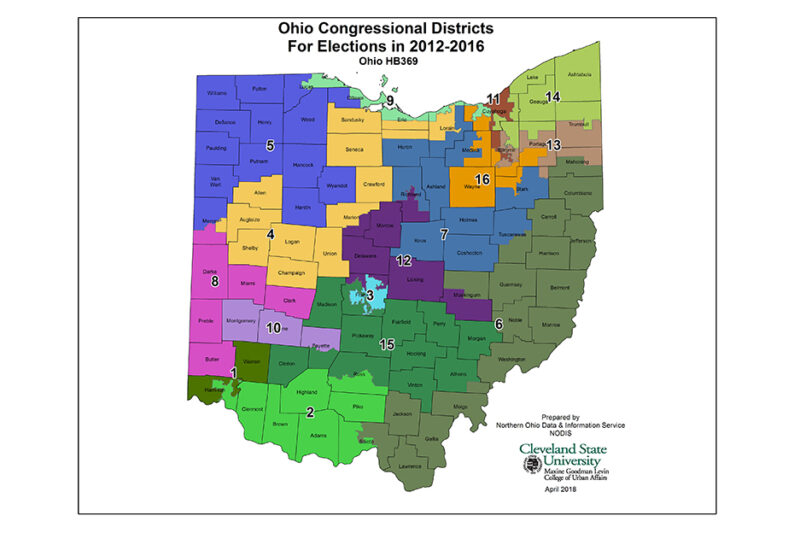
UPDATE (2/27/2019): A federal trial, where the ACLU will argue that that Ohio's congressional map violates the Constitution, will begin on March 4 in Cincinnati, Ohio. The witness list includes plaintiffs, political scientists, former state Sen. Nina Turner, U.S. Rep. Marcia Fudge, and former U.S. House Speaker John Boehner, among many others.
We all know how representative democracy is supposed to work — each election cycle, citizens vote to determine which elected officials will represent them in Congress. That’s not what’s happening in Ohio, where Republicans designed the state’s redistricting map to keep their party in office in violation of voters’ constitutional rights.
Today, the ACLU filed a lawsuit seeking to replace Ohio’s gerrymandered map with one that reflects the will of voters and complies with the Constitution before the 2020 elections.
How did Ohio become one of the most egregious examples of partisan gerrymandering in modern history? It’s a sordid tale involving high-level Republican operatives, a secret “bunker,” a rushed vote, and enormous consequences for our democracy.
Here’s what you need to know.
How are congressional districts drawn?
U.S. voters are grouped into districts that elect members of Congress, state legislators and many local offices. These districts are typically redrawn every 10 years, based on the results of the U.S. Census. Under current Ohio law, the state’s General Assembly — its legislature — is primarily responsible for drawing the state’s congressional districts, under the advisement of a bipartisan legislative task force.
What happened in Ohio?
In anticipation of the 2010 Census, the national Republican State Leadership Committee (RSLC) came up with a plan to secure Republican control of state legislatures, with a focus on states where legislative bodies controlled the congressional redistricting process. The RSLC identified Ohio as one of those states and spent nearly $1 million on Ohio House of Representatives races in advance of the 2010 election. Ahead of the election, the Republican National Committee also conducted a training session on redistricting, attended by the chief legal counsel for the Ohio House Republican Caucus. The theme of the session was “keep it secret, keep it safe.”
In the 2010 election, Ohio Republicans succeeded in securing single-party control of the state and quickly got to work on drawing a map that would deliver favorable results for the next 10 years.
National GOP officials also stepped up their support of local redistricting efforts. In a letter to all Republican state legislative leaders nationwide, Chris Jankowski, then-president and chief executive officer of the RSLC, offered a “team of seasoned redistricting experts available to you at no cost to your caucus for assistance.”
In the summer of 2011, two of the highest-ranking Republican staffers in the state — the chiefs of staff to the Ohio Senate and the Ohio House of Representatives — hired two Republican political operatives, Ray DiRossi and Heather Mann, as consultants to undertake research and other activities for drafting the congressional map. They were retained exclusively by the Republican members of the supposedly bipartisan task force.
Several other national Republican Party operatives also got involved with the drafting the map. Beginning in July 2011, the redistricting operations were based out of a secretly rented hotel room at the DoubleTree Hotel in Columbus, Ohio, rather than in the offices of the General Assembly. The national operatives and state officials driving the redistricting process referred to it as “the bunker.”


%3Ciframe%20allow%3D%22autoplay%3B%20encrypted-media%22%20allowfullscreen%3D%22%22%20frameborder%3D%220%22%20height%3D%22315%22%20scrolling%3D%22no%22%20src%3D%22https%3A%2F%2Fwww.youtube.com%2Fembed%2FtMQFENSgOl8%3Fautoplay%3D1%26version%3D3%22%20thumb%3D%22%2Ffiles%2F2018-05-22-oh-gerrymandering-thumbnail-embed.jpg%22%20width%3D%22530%22%3E%3C%2Fiframe%3E
Privacy statement. This embed will serve content from youtube.com.
The operatives and Ohio Republican officials often used their personal, rather than official, email addresses to conduct and discuss the state business of drawing Ohio’s congressional map. The draft map was kept from the public, the full task force, and even from members of the General Assembly until just two days before the full Ohio House would vote on it in September 2011.
The map passed. Democratic leaders and advocacy groups quickly sought a referendum to allow the public an opportunity to repeal the map. Under threat of repeal, Republicans moved quickly to pass a slightly revised version. However, the revisions did nothing to change the partisan make-up of any of the proposed districts or the dramatic advantage it provided the Republicans.
What did the operatives do to the map?
Using partisan indices to draw the districts, the operatives designed a map that would allow Democrats to win four districts, while ensuring Republican wins in the state’s other 12 districts.
As a result of the new map, Republican candidates earned 51 percent of the statewide vote in 2012, but secured 75 percent of the state’s congressional seats. In 2014, they earned 59 percent of the vote, and again held onto 75 percent of the seats. In 2016, the Ohio GOP took 57 percent of the vote, and — yet again — kept 75 percent of the Congressional seats.
Ohioans who had voted as Democrats in past elections were “packed” into four irregularly shaped, barely contiguous districts, reducing their political power throughout the state. This resulted in unusually large margins of victory for Democrats in all four districts.
A prime example of packing is District 9, referred to as the “Snake on the Lake” because of how it ingests portions of five counties but contains none in their entirety. (See the map below.)
District 9 includes fragments of two of Ohio’s major cities: Cleveland and Toledo. After the 2011 redistricting, two Democratic candidates for U.S. House of Representatives — Marcy Kaptur of Toledo and Dennis Kucinich of Cleveland — were forced into a primary election, where only one would survive.
One of our plaintiffs, Chitra Walker, lives in Lakewood, a city that is part of the Cleveland area in District 9. Instead of belonging to the same district as others living in Cleveland, she shares a district with people living in Toledo, which is 108 miles away.

Ohio’s map also splits the Democratic vote in the remaining districts to dilute their votes — a tactic known as “cracking.” For example, District 1 encompasses two barely connected wings of Hamilton County and Warren County. It includes part of Cincinnati, but not the whole city. Prior to the 2011 redistricting process, District 1 was competitive — it swung back and forth between Republicans and Democrats, including in 2008 when a Democrat won the district. Then in 2011, heavily Republican Warren County was added to the district, and it has been Republican ever since. (See map below.)

Is partisan gerrymandering unconstitutional?
Partisan gerrymandering like Ohio’s contradicts the core principle of a representative democracy — that voters should choose their elected officials, and not the other way around. Rather than reflecting voters’ dynamic or evolving preferences, elections under gerrymandered systems systematically lock in candidates from the legislators’ preferred party, and discourage electoral competition.
Ohioans of all party affiliations have the First Amendment right to associate for the advancement of their political beliefs, to express their political views, and to participate in the political process. When state officials intentionally skew electoral outcomes to inoculate their party against changes in voter preferences, they undermine that right. Just as the First Amendment demands governmental neutrality in regulating the competition of ideas in a public forum, it also requires neutrality in administering the ideological competition of public elections.
Partisan gerrymandering also deprives voters of the opportunity to cast a “meaningful ballot” — a substantial burden on the constitutional right to vote — and violates voters’ 14th Amendment right to equal protection and treatment under the law.
In Ohio’s case, the map was clearly enacted with intent to disfavor Democratic voters on the basis of their political affiliation. As a result, Democratic voters in Ohio have less power to effect change or demand representation on issues that are central to their lives.
Do both parties engage in partisan gerrymandering?
Absolutely — and it’s unconstitutional whichever party does it.
Prior to bringing this suit, the ACLU filed amicus briefs in two partisan gerrymandering cases currently before the Supreme Court. In Benisek v. Lamone, we supported Republican voters in Maryland who are contesting congressional redistricting lines drawn by the Democrats.
In Gill v. Whitford, we supported Wisconsin Democratic voters challenging the legislative redistricting drawn by the majority Republicans. Ironically, so did Governor John Kasich, who signed Ohio’s rigged map into law and is a named defendant in our suit.
In his amicus brief, Governor Kasich wrote, “Partisan gerrymanders are unconstitutional, are harming our republican government, and readily can be identified and addressed by courts.”
The governor was absolutely right. Now is the time to fix partisan gerrymandering in his state.



